Vase with waves and animal masks
With its long neck and round body, this flower vase takes the form of a ritual wine container (hu), first produced in China during the Shang (ca. 1600–1046 BCE) and Zhou (ca. 1046–256 BCE) dynasties. The mask-like imagery on its lower section has similar roots. Such details reveal the growing popularity of antiquarianism in China from the twelfth to the fourteenth century. The pattern of cresting waves at the top of the vase, on the other hand, is a motif faithful to contemporary paintings, ceramics, and other art forms.
Artwork Details
- 元 雲耳波濤獸面紋銅瓶
- Title:Vase with waves and animal masks
- Period:Yuan dynasty (1271–1368)
- Date:late 13th–14th century
- Culture:China
- Medium:Copper alloy
- Dimensions:H. 7 1/4 in. (18.4 cm); W. 3 3/8 in. (8.6 cm); D. 2 5/8 in. (6.7 cm)
- Classification:Metalwork
- Credit Line:Purchase, The B. D. G. Leviton Foundation Gift, 1987
- Object Number:1987.112
- Curatorial Department: Asian Art
More Artwork
Research Resources
The Met provides unparalleled resources for research and welcomes an international community of students and scholars. The Met's Open Access API is where creators and researchers can connect to the The Met collection. Open Access data and public domain images are available for unrestricted commercial and noncommercial use without permission or fee.
To request images under copyright and other restrictions, please use this Image Request form.
Feedback
We continue to research and examine historical and cultural context for objects in The Met collection. If you have comments or questions about this object record, please contact us using the form below. The Museum looks forward to receiving your comments.
